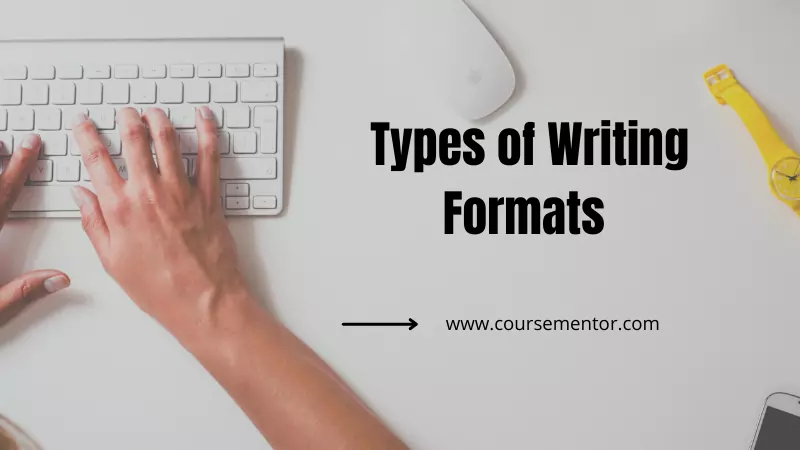Writing is a powerful tool for communication, allowing us to express our thoughts, ideas, and emotions. However, the effectiveness of our message usually depends on the format in which it is presented.
Different writing formats serve different purposes and focus on different audiences. This blog will explore the most common types of writing formats and their basic page formation.
Whether you are a student, a professional, or simply interested in improving your writing skills, understanding these formats will help you to convey your message effectively.
So, let’s get started!
What are Writing Formats?
Formats for writing are the ways that written text is put together and shown. There are many different ways to write, each with its style and goal. Some of the most popular ways to write are:
Expository: This type of writing is used to explain something or describe it. The structure of most expository writing is clear and logical, with each line building on the one before it.
Argumentative: This type of writing is meant to convince the reader to agree with a certain point of view. Argumentative writing usually backs up its claims with facts and reasoning.
Narrative: This type of writing is used to tell a story. Most narratives are written in order of time, with each event leading to the next.
Descriptive: This type of writing is used to explain something in detail. Most descriptive writing uses strong words and images to paint a clear picture in the viewer’s mind.
Procedural: This type of writing shows how to do something. Writing about how to do something usually goes step by step, clearly describing each step.
The style you choose for your writing will depend on why and who you are writing for. For example, you may use an expository style when writing a research paper. You can use a narrative style when writing a blog post.
It’s important to know the different writing styles to choose the one that best fits your needs. Many writing guides and style manuals have more knowledge about writing styles.
7 Major Types of Writing Formats in Detail with Suitable Examples
Writing formats express your ideas in a certain way or structure. There are seven major types of writing formats:
- Chicago style or CMS
- APA style
- MLA style
- Turabian style
- IEEE style
- Harvard style
- AMA style
In academic papers, several writing formats are used to organize the content, which can also help you get better marks on your project. These writing styles include Chicago or CMA, APA, MLA, Turabian, and IEEE. We have explained seven major types of writing formats below:
What is Chicago style or CMS?
This style is known as Chicago or CMS because the University of Chicago Press published the style in 1906. It is used for formatting your academic essays and making references. The Chicago style is somehow less common than APA or MLA style.
Chicago style is mainly used in humanity, literature, arts, and history. Chicago style is rarely used outside of it.
This style is also known as CMS ( Chicago Manual Style ). This is the first format from the types of writing formats.
General Format of Chicago Style:
- Print the paper standard-sized (8.5 X 11 inches).
- The body text of the paper should be double-spaced in Chicago style.
- Set the paper margins to not less than 1 inch on all sides and not greater than 1.5 inches.
- Use readable fonts on the paper.
- The font size should be not less than 10 points. On the other hand, a 12-point font size is preferable.
- The paper header should have a number in the upper right-hand corner.
Title Page
- The title page should be double-spaced and center-aligned.
- The page title is in the same font as the rest of your text.
- The title should be in the middle of the page, in the headline and bold text.
- Use subtitles after the main title ends with a colon if you have subtitles. The subtitle should be bold and the same size as the main title
What is APA style?
The American Psychological Association created the APA style in the year of 1929. The APA style is generally used in education, engineering, social science, etc. It consists of in-text citations that mention the Author’s last name, the date of publication, and the page number, if necessary. This is the second format of the types of writing formats.
APA Formatting Basics:
- All text should be double-spaced in APA style.
- Set the paper margin to one inch on all sides.
- All paragraphs in the body end with intended lines.
- Ensure the title is centered on the page with your name, institution, or school.
- A 12-point font is preferable in APA style.
- The paper number should be in the upper right-hand corner.
- It is recommended to use one space after most punctuation marks.
Title page
- Do not use unnecessary words on the title page. Hence, use only those words which are suitable.
- Always center the title on the page. In other words, place it about 3-4 lines from the top.
- The title should be bold.
- Do not underline your main title.
- The title page should be double-spaced.
- Do not include any titles in the Author’s name.
What is MLA style?
The Modern Language Association created the MLA style in the year of 1951. This type of style is used in various humanities disciplines, especially in the language. This style of writing is popular among students of literature and language. This is the third format from the types of writing formats.
Some of the key features of the MLA style writing format:
- The MLA style uses the font Times New Roman with a font size of 12.
- Set Margins with one-inch space on all sides.
- The titles of the MLA style are always in Italics.
- The essay is always double-spaced in MLA.
- Make sure the title is in the center.
- Indent every new paragraph with one and a half-inch.
Title page
Here are the steps you need to take to create the MLA title page:
- Skip down one-third of the page and type the title of your paper.
- If you have a subtitle, write it in the following line to the title.
- You can skip to the bottom third of the page to type your first and last name.
- After that line, type the course name and number if needed.
- Then type your instructor’s name.
- On the next line, type your paper’s due date in the format of Day, Month and Year.
What is Turabian style?
Kate Larimore Turabian designed the Turabian style in the year of 1937. The Turabian format is commonly considered under the Chicago format because both are identical. It is designed for students and researchers. Turabian style is a version of Chicago style and follows conventions of Chicago style but also adds extra points for the formatting of research papers.
Turabian style made a few modifications to the format so that notes can be used instead of parenthetical citations that is used to modify the flow of the text. This is the fourth format of the types of writing formats.
General Format of Turabian Style:
- You can always set the margins to one inch on all sides.
- A 12-point font is preferable in Turabian style.
- Indent every new paragraph with one and a half-inch from the body.
- Double-space the whole paper.
- Except for table titles, blockquotes, bibliography entries, footnotes, reference lists, and figure captions.
Title page
- Text on your title page should be in the font you used for the main content.
- Text is always double-spaced and center-aligned.
- Do not feature a page number on the title page.
What is IEEE Style?
IEEE stands for the Institute of Electrical and Electronics Engineers. It is an association of electrical engineering and its associated disciplines. It was formed in the year of 1963 based on two American establishments.
IEEE also uses the Chicago style as its foundation. The in-text references are also similar to the Chicago style. The main difference lies in how the citation references are formatted in the bibliography. It is widely used by students and researchers in technical fields and computer science.
IEEE is the largest association of technical professionals globally that sets the bar for aspiring technical researchers. The IEEE has established its writing style manual. This is the last format from the types of writing formats.
Basic page formation in IEEE format:
- The paper title should be 24pt font, placed on the front page and centered at the top.
- The byline should be placed below the paper title after the line break. The byline includes information like Author’s name, City location, E-mail address, and Author’s affiliation.
- The main body text is written in a 10pt font size.
- Use four levels of hierarchy in the Heading.
Title page
- The page titles of all IEEE digital pages include the article’s title, byline, membership, and footnote.
- Any hyphenated word will be in capital letters.
What is Harvard style?
The Harvard style is widely used in social sciences, particularly in fields like business, economics, and political science. It highlights author-date citations and a reference list at the end of the document. This format is also known as the Author-Date style.
Basic page formation in Harvard format:
- All text citations must be at the end of your paper.
- The reference list must contain all the important information that one must know to find the source of your writing.
- The reference list must be in alphabetical order.
- Start your reference list from a new page.
Title page:
- Typically the title page is not recommended in Harvard-style format.
What is AMA (American Medical Association) style?
The AMA format is used in the medical and biological sciences. It provides guidelines for mentioning sources and formatting research papers, case reports, and other medical documents.
Basic page formation in AMA format:
- The 1-inch margin on all sides of the paper
- The paper is double-spaced, including the block quotes, title page, and references.
- Use the serif typeface Times New Roman or Arial.
- Use a 12pt font size throughout.
Title page:
- All text is center aligned and must be double-spaced.
- The full title of the paper begins a quarter down the page.
- Author’s full name(s), including middle initials.
- Course Number – Course Name
- Assignment: Assignment Name if required
- Affiliated institution
Final Words
If you think you’re the one choosing the writing format, then you’re wrong. The writer doesn’t get to choose the correct writing format for the project.
Rather than a professional or manager will often assign the format for you. This blog provides you with seven major types of writing formats: Chicago or CMS, APA, MLA, Turabian, IEEE, Harvard, and AMA.
We also provide you with basic page formation of each writing format. Hope you like this Blog!
Also, Read: Different Types of Writing Styles
FAQs
What are the different types of writing?
There are many types of writing that are used in multiple aspects of life:
1. Advertisement Writing
2. Letter Writing
3. Precis Writing
4. Message Writing
5. Report Writing
6. Speech Writing
7. Essay Writing
8. Summary Writing
9. Playwriting
10. Feature Writing
What are the different types of tones in writing styles?
The writing style has four main tones: descriptive, persuasive, expository and narrative.
Can a single piece of writing include multiple formats?
Yes, combining different writing formats within a single piece of writing is possible. This can improve the richness and effectiveness of the message, allowing the writer to cover different aspects of the topic or engage various reader preferences.
Do writing formats change over time?
Writing formats can evolve due to technological changes, cultural shifts, and communication styles. Writers need to stay informed about current trends and adapt their writing accordingly.
Are there any specific guidelines for each writing format?
Yes, each writing format has its own set of guidelines and patterns. Familiarize yourself with the expectations and style guides specific to each format to ensure your writing meets the standards.





